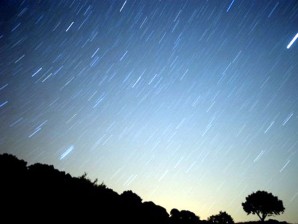
A meteor streaks across the sky against a field of stars during a meteorite shower early August 13, 2010, near Grazalema, southern Spain. Early risers have until the last day of July 2013 to witness a “nice display of meteors on moonless mornings,” according to the astronomical division of the Philippine weather bureau. AFP PHOTO/JORGE GUERRERO
MANILA, Philippines—Early risers have until the last day of July to witness a “nice display of meteors on moonless mornings,” according to the astronomical division of the weather bureau.
The Southern Delta Aquarids meteor shower will be best observed across Philippine skies from July 28 to 31, with the spectacle expected to peak before midnight and onward on July 30, the Philippine Atmospheric, Geophysical and Astronomical Services Administration (Pagasa) said.
In its monthly astronomical diary, Pagasa said stargazers would, under favorable conditions, be able to see five to 10 meteors an hour during the shower.
“The stream normally produces about 5 to 10 meteors per hour with overall activity of about 15 meteors per hour under good sky conditions,” the astronomical diary issued by Pagasa officer in charge Vicente Malano said.
The Southern Delta Aquarids are part of a complex of radiants—or the points in the sky where the meteors come from—in the constellations Aquarius, Capricornus and Piscis Austrinus.
“All of [these] combine with sporadic and early Perseid activity to provide a nice display of meteors on moonless mornings in late July,” Pagasa said.
In an online article, the US National Aeronautics and Space Administration (Nasa) said the Delta Aquarids were best viewed in the southern hemisphere and the southern latitudes of the northern hemisphere.
Nasa also provided tips on the best way to view the meteor shower.—DJ Yap